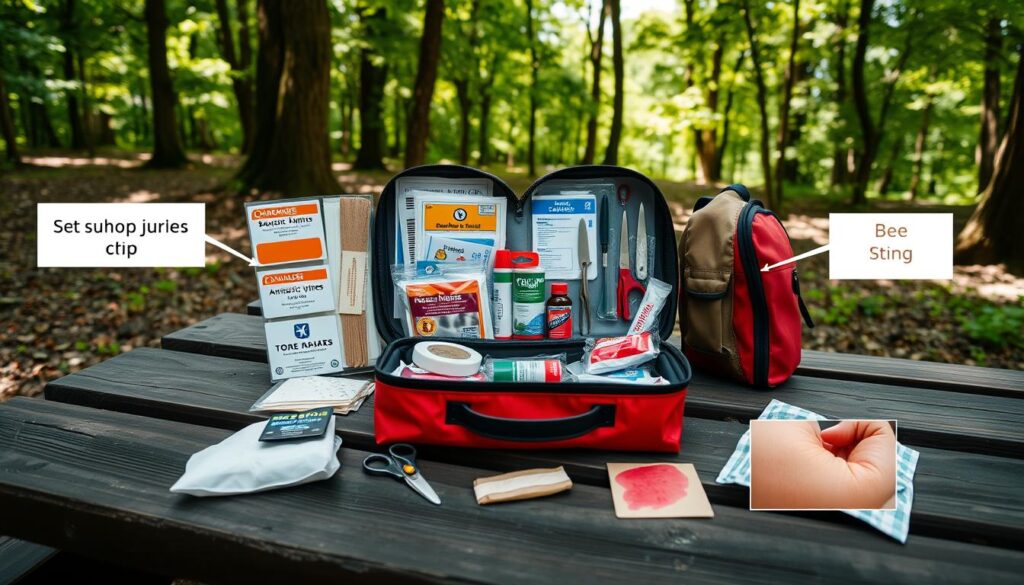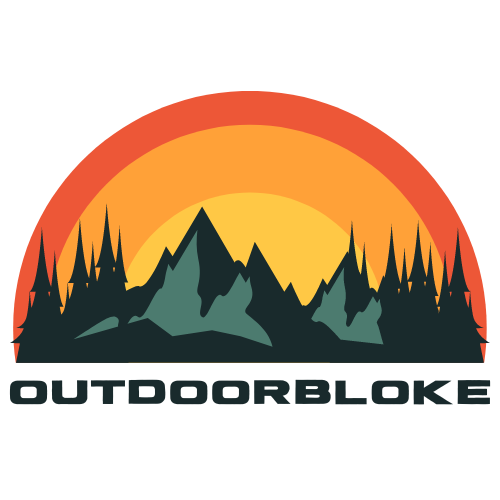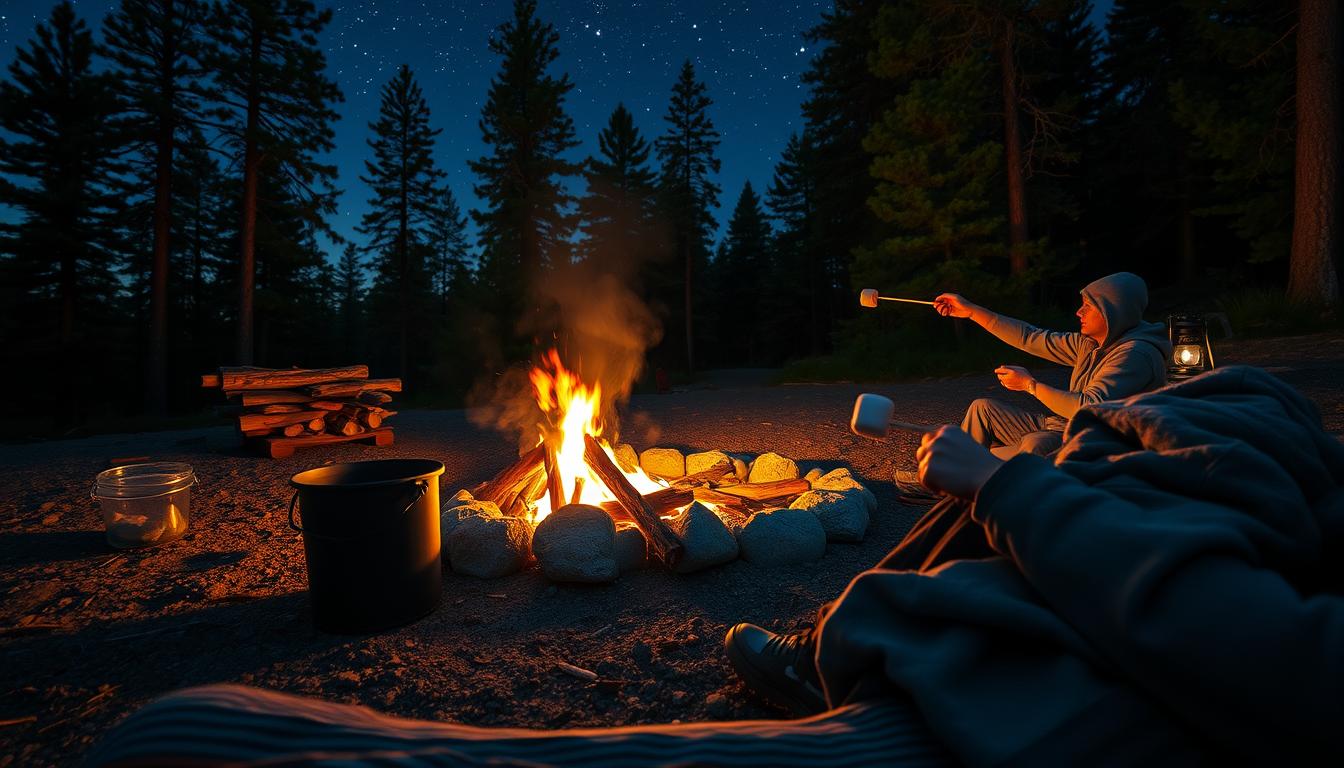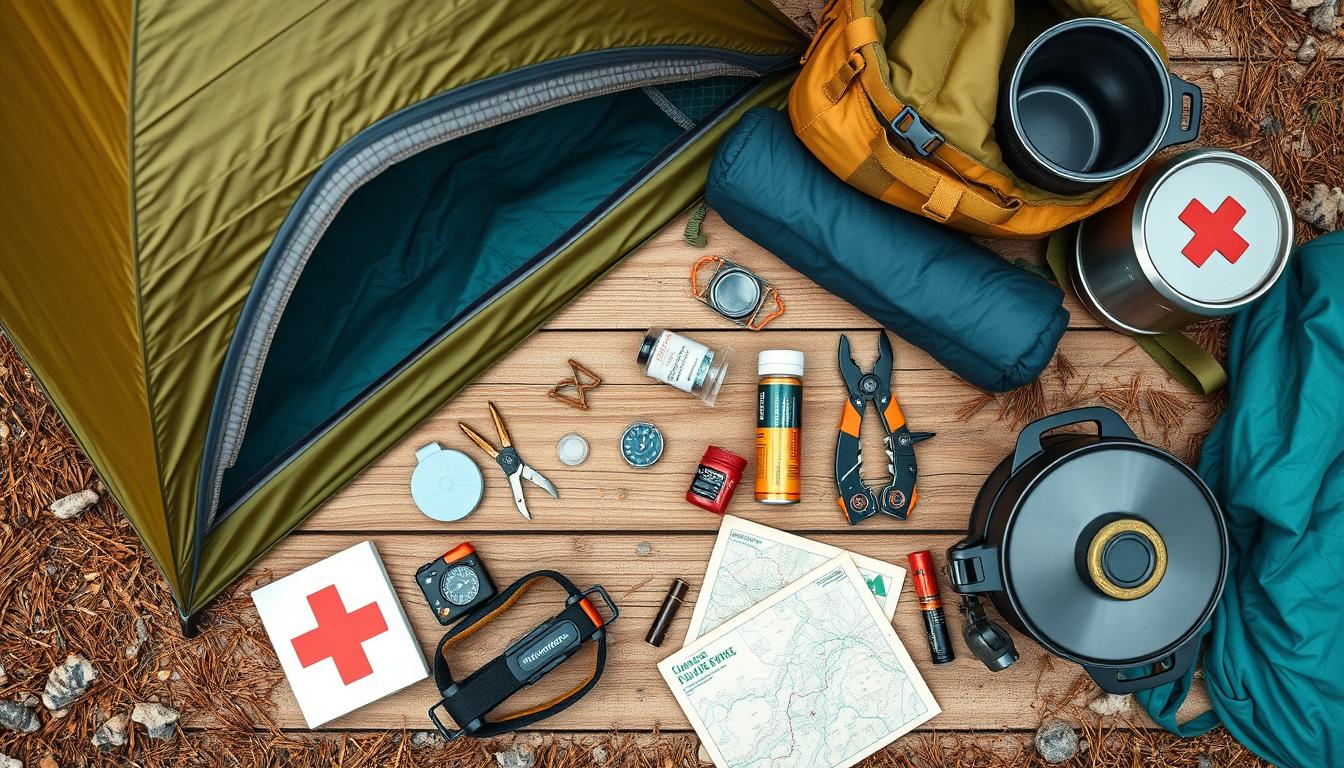When I go camping, I always make sure to have a first-aid kit ready. It’s very important to have a good first-aid kit because camping can be unpredictable. Having the right medical supplies is key for my safety and that of my friends.
Adding the right items to my kit makes our camping trips better. In this guide, I’ll show you how to create your own camping first-aid kit. We’ll look at the essential items you need, based on your specific needs and situations.
Key Takeaways
- Understanding the necessity of a camping first-aid kit is crucial for safety.
- Customizing my first-aid kit according to my camping activities enhances preparedness.
- Having essential medical supplies readily available can improve the overall camping experience.
- Learning how to make your own camping first-aid kit allows for tailored solutions.
- Regularly updating and checking the contents of the kit is essential for effectiveness.
Understanding the Importance of a Camping First-Aid Kit
Having a camping first-aid kit is very important. Many campers don’t realize how crucial first aid is for outdoor activities. A good first-aid kit is a key safety tool. It can help treat small problems before they become big emergencies.
While camping, you might get cuts, bites, or have allergic reactions. These issues can get worse fast without the right first-aid. Knowing the importance of first aid while camping is key, especially when help is far away.
Having the right items in your first-aid kit is essential for safety. A good kit gives you peace of mind. It lets you enjoy the outdoors more, knowing you’re ready for anything.
| Injury Type | First-Aid Response | Essential Kit Item(s) |
|---|---|---|
| Cuts and Scrapes | Clean and cover the wound. | Antiseptic wipes, bandages |
| Insect Bites | Remove stinger, apply cold compress. | Antihistamines, hydrocortisone cream |
| Allergic Reactions | Administer antihistamines; if severe, use an EpiPen. | EpiPen, antihistamines |
The Must-Haves for a Camping First-Aid Kit
When I put together a camping first-aid kit, I focus on the essentials. These items are crucial for safety and readiness. They help with common injuries and emergencies while camping. Here are the key items I include in my kit.
My list of camping first-aid essentials covers many scenarios. The main items are:
- Adhesive bandages: For minor cuts and scrapes.
- Antiseptic wipes: To clean wounds and prevent infection.
- Gauze pads: Essential for covering larger wounds.
- Adhesive tape: Useful for securing gauze and dressings.
- Single-use hydrocortisone cream: Helps relieve itching and inflammation.
It’s important to think about the trip’s length and the number of people. Longer trips or bigger groups might need more supplies. This includes extra gauze pads or more antiseptic wipes.
Having these must-haves ready can greatly improve safety on outdoor adventures. It ensures we’re ready for any situation, especially when help is needed most.
How to Make Your Own Camping First-Aid Kit
Making a first-aid kit for camping is rewarding. It needs planning and knowing what’s essential. I aim for a simple yet effective kit, making sure it has everything I need.
Gathering Essential Items
Starting a DIY camping first-aid kit means knowing what you’ll need. Here’s a list of basic items:
- Adhesive bandages in various sizes
- Antiseptic wipes or spray
- Gauze pads and tape
- Some tweezers and scissors
- Pain relievers like ibuprofen or acetaminophen
- Anti-itch cream for insect bites
- Elastic bandage for sprains
- Emergency blanket
This list is a good start. I adjust it based on my trip’s activities, like hiking or swimming.
Choosing the Right Container
Next, pick a good container for first-aid kit. It should protect your supplies and be easy to access. I look at:
- Waterproof bags for lightweight trips
- Hard cases for maximum protection
- Portable pouches that fit easily into backpacks
Choosing the right container keeps your supplies organized and safe. Thinking about these details helps me stay ready for any outdoor adventure.

Key Components of a DIY Camping First-Aid Kit
When making a DIY camping first-aid kit, it’s key to include important items for outdoor situations. A good kit has several parts, making it easy to find what you need. I focus on three main areas: wound care, medications, and emergency tools. Each part has a special role in keeping you safe on outdoor adventures.
Wound Care Supplies
Wound care is crucial for camping injuries. The right supplies help manage cuts, scrapes, and more. Here are some must-haves:
- Butterfly bandages for closing small wounds
- Antiseptic ointments to prevent infection
- Sterile compresses for larger wounds
- Adhesive bandages in various sizes
- Gauze pads and medical tape for dressings
Medications and Pain Relief
A good outdoor first-aid kit has medications for common issues. It’s important to have these on hand:
- Ibuprofen for pain and swelling
- Antihistamines for allergies
- Aspirin for heart issues
- Personal prescriptions if needed
Emergency Tools and Accessories
Emergency tools and accessories are crucial in a DIY camping first-aid kit. They help you care for injuries and stay prepared:
- Scissors for cutting bandages and tape
- Tweezers for removing splinters or ticks
- A flashlight for light at night
- A whistle to signal for help
Together, these items make up a complete DIY camping first-aid kit. With wound care, medications, and tools, you’re ready for anything the outdoors throws your way.
Steps to Making a Camping First-Aid Kit
Making a camping first-aid kit needs careful planning. I find it helpful to follow steps to make sure I have everything I need. This ensures the kit is tailored to my personal needs and the camping location.
First, I think about the risks of my trip. This includes hiking in remote areas or dealing with insect bites. Knowing these risks helps me pick the right items for my kit.
Then, I sort my supplies into categories. This makes it easier to find what I need when I’m in a hurry. I organize my kit into sections like:
- Wound care supplies
- Medications and pain relief
- Bandages and dressings
- Emergency tools
Organizing my kit this way helps me find what I need fast. I also make sure everything is clean and not expired. This keeps my kit effective and safe.
For my DIY kit, I use a strong, waterproof container. This keeps the supplies dry and ready to use. I label the inside of the container so I can find what I need quickly.
Following these steps helps me make a first-aid kit that’s right for my outdoor adventures. It makes me feel more confident and safe while camping.
| Step | Description |
|---|---|
| 1 | Assess potential risks based on location and activities. |
| 2 | Gather and categorize essential supplies. |
| 3 | Organize components in a waterproof container. |
| 4 | Label sections for quick access to items. |
| 5 | Regularly check and update for expiration and damage. |
Camping First-Aid Essentials for Common Injuries
Exploring the outdoors can be fun, but it’s important to be ready for injuries. Knowing how to treat cuts, scrapes, sprains, and burns is key. I’ve gathered essential first-aid tips to help me respond quickly and effectively.
Dealing with Cuts and Scrapes
Handling first aid for cuts and scrapes is crucial. Start by cleaning the wound with clean water. Use an antiseptic wipe if needed. Then, cover it with a sterile bandage to keep it clean.
Check the bandage often to keep it dry and clean. A well-stocked first-aid kit is essential for these injuries.
First Aid for Sprains and Strains
Sprains and strains are common, especially when hiking. The R.I.C.E. method is the best way to treat them:
- Rest: Stop any activity that causes pain.
- Ice: Apply ice packs for 15-20 minutes to reduce swelling.
- Compression: Use a bandage to compress the injury.
- Elevation: Keep the injured area elevated to reduce swelling.
Knowing these steps helps me manage sprains effectively while camping.
Burn Treatment Essentials
Burns can happen from cooking accidents or sun exposure. Cool the burn with cool water or a damp cloth. Don’t use ice, as it can make it worse.
After cooling, cover the burn with a sterile bandage. It’s important to know when to seek medical help. Burns that blister or cover a lot of skin need immediate care. Understanding these steps keeps me safe during outdoor adventures.
For more detailed information and a list of first-aid kit essentials, check this first aid checklist for camping.
| Injury Type | Primary Treatment | Key Supplies |
|---|---|---|
| Cuts and Scrapes | Clean and cover the wound | Antiseptic wipes, bandages |
| Sprains and Strains | R.I.C.E. method | Ice packs, compression bandage |
| Burns | Cool and cover | Cool water, non-adhesive bandages |
Tips for Assembling a Camping First-Aid Kit
Keeping a good camping first-aid kit is key to outdoor safety. It’s important to follow some tips for putting together a kit. Regularly checking your supplies helps keep everything fresh and ready for your next trip. Tailoring your first-aid kit to your activities makes you better prepared for any situation.
Regularly Check and Update Your Kit
Make it a habit to check your first-aid supplies before every trip. This way, you can spot any missing or expired items. It’s a good idea to have a checklist to help you stay organized:
- Inspect bandages and dressings for availability.
- Check medications for expiration dates.
- Ensure emergency tools, like scissors and tweezers, are functioning properly.
- Restock any items used during previous trips.
How to Personalize Your Kit Based on Activities
Each camping activity comes with its own set of risks. Personalizing your first-aid kit means thinking about the specific dangers you might face. For example:
| Activity | Additional Supplies Needed |
|---|---|
| Backpacking | Blister treatment, stretch bandages |
| Hiking | Snake bite kit, insect bite treatment |
| Family Camping | Pediatric medications, sunscreen |
By making your first-aid kit specific to your activities, you can feel more confident and safe. This careful planning is essential for a safe adventure in the outdoors.
Practice and Prepare for Emergencies
Being ready for emergencies is crucial when camping. It’s important to practice first-aid skills often and involve everyone. Doing first aid drills helps family and friends know their roles. This makes them more confident and ready to handle real emergencies.
Conducting First Aid Drills
I set up first aid drills for realistic camping scenarios. This helps the group learn the procedures and use the first-aid kit. Here’s how to do it:
- Identify potential emergencies, such as cuts, burns, or sprains.
- Assign roles to participants, ensuring everyone knows what to do.
- Use practice scenarios that mimic real situations to enhance learning.
- Debrief after each drill, discussing what worked and what needs improvement.
Learning Basic First-Aid Skills
Learning first-aid skills is vital for any camper. Taking a course from a certified group like the Red Cross is a good idea. It teaches you the skills you need in emergencies. Some important skills include:
- Administering CPR and dealing with choking incidents.
- Effective wound care and bandaging techniques.
- Recognizing and treating shock.
Practicing first-aid for camping makes me quicker and more effective in emergencies. The more I practice, the more ready I am for anything.
| First-Aid Skill | Benefits |
|---|---|
| CPR Training | Increases chances of survival during cardiac emergencies. |
| Wound Care | Prevents infections and promotes healing. |
| Burn Treatment | Reduces pain and potential complications from burns. |
Conclusion
Thinking about a DIY camping first-aid kit shows how key preparation is for safe outdoor fun. A good kit gives me peace of mind and helps me deal with unexpected health issues. It’s crucial to include the right items for health and safety while camping.
Building and checking my first-aid kit regularly makes me ready for anything. Knowing how to handle emergencies makes a big difference. This shows how important it is to be prepared when camping.
My dedication to safety through a well-prepared first-aid kit changes my camping trips and those of my friends. With the right tools and knowledge, I’m ready for any adventure. I face each outdoor journey with confidence and preparedness.





Leave a Reply